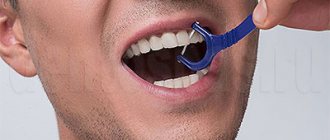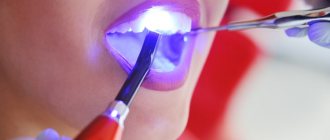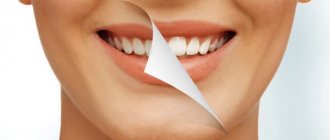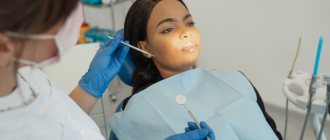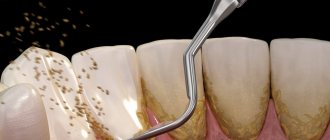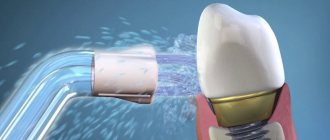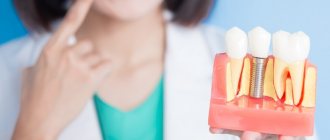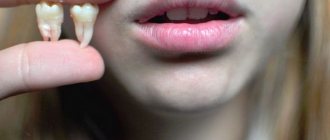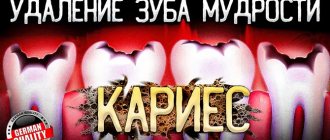Everyone wants to be the owner of a beautiful snow-white smile. This is why professional teeth whitening has become so popular recently. But in order for the result to be maximum and last a long time, you need to follow some rules for oral care. If you do not follow the specialist’s recommendations, fairly soon after the procedure your teeth will return to their previous shade.
Why do teeth become sensitive after whitening?
In the first days after the procedure, the enamel will be more sensitive; minor pain and reaction to temperature stimuli may occur. This is a completely normal phenomenon, since the teeth were exposed to aggressive external influences. However, there should not be acute pain - this situation indicates that the doctor chose the wrong dosage of the active substance.
Even the safest and gentlest whitening methods still have a negative effect on the enamel, destroying its mineral composition. Therefore, it is necessary to introduce healthy foods into the diet (see the list below), as well as use various preparations that will strengthen your teeth - in pharmacies you can purchase special pastes or compositions that are applied to the teeth for a few minutes.
Rules for brushing teeth
You should brush your teeth after every meal. To clean, you need to use a brush with soft bristles, since bristles that are too hard can damage the enamel. Toothpaste should be designed for sensitive teeth. It is not recommended to use products with abrasives, and when purchasing a whitening paste, it is advisable to follow the advice of a dentist.
After cleaning, you should floss between your teeth. Dental floss provides more effective cleaning and allows you to remove food particles in hard-to-reach places. At the final stage, use a rinse aid containing fluoride. Its use allows you to remove remaining dirt and strengthen the enamel.
We know how to whiten teeth
What diet should you follow after teeth whitening?
After bleaching, the enamel becomes more porous, and therefore there are certain restrictions in terms of nutrition and hygiene procedures. Therefore, after the lightening procedure, adhere to the “white diet”: exclude foods and drinks that contain coloring pigments and can lead to a change in the shade of the enamel. It is worth minimizing the amount of coffee, black tea, dark vegetables and fruits consumed.
To strengthen the enamel, introduce into your diet foods that contain large amounts of calcium and fluoride: milk, kefir, cottage cheese, fish, cheeses, eggs.
It is worth excluding factors that provoke unpleasant sensations, namely, too hard food, excessively hot and cold drinks. Follow the recommendation for an average of a week or longer, if necessary. It is also better to exclude sour and spicy foods from the diet: citrus fruits, sauces, ketchup, curry and other seasonings can increase tooth sensitivity.
What does plaque on teeth from smoking look like?
Plaque on teeth from smoking is usually yellow or brown. A few hours after brushing your teeth, the enamel is covered with a microbial film, which is easily removed with a brush and toothpaste. But in a smoker, the immune system in the oral cavity is significantly reduced and the process of reproduction of cariogenic microorganisms is more active. Therefore, a yellow-brown plaque forms faster than in a non-smoker.
You can look at what plaque on your teeth from cigarettes looks like. It differs in shade and density, depending on the duration of smoking.
Some people develop black deposits on their teeth, which indicate serious problems in oral health and may indicate the development of deep caries. Carious cavities and spots are invisible under the plaque. They can hide the initial signs of enamel damage.
In addition to plaque, other symptoms appear when smoking:
- bad breath;
- bleeding gums;
- exposure of the necks of the teeth;
- increased sensitivity of enamel;
- early tooth loss.
But infectious complications, which often arise when plaque on teeth from smoking is ignored, can be avoided. To do this, it is necessary to constantly maintain high quality oral care, carry out professional cleaning in the dentist's office and use home enamel lightening methods.
Hygienic care rules
- Do not use a toothbrush with hard bristles - it will only increase the sensitivity that occurs immediately after the whitening procedure. It is better to give preference to a brush of medium hardness, since one that is too soft will not cope with removing plaque,
- Toothpaste should be free of abrasive substances that can damage the enamel. The best option is a paste to reduce hypersensitivity. It should be used for the first 2-3 weeks after whitening. Afterwards, it can be replaced with a paste that contains fluoride - this will be an excellent option for strengthening enamel and protecting against caries,
- After eating food (especially “coloring”), you should pay special attention to hygiene - use dental floss or a irrigator after each meal. And not only in the first days after whitening, but also in the subsequent ones - this recommendation should become a useful habit,
- Mouth rinses should not contain chlorhexidine, as it causes permanent staining of tooth enamel.
Even after whitening, you need to visit the dentist 1-2 times a year (but not earlier than six months later). Professional hygiene and removal of dental plaque will preserve the results and will be an excellent prevention of caries.
Women should avoid using lip gloss and bright lipstick for the first few days after whitening.
Soreness after a session: what does it mean?
Quite often people have toothache after whitening. What to do in such an unpleasant situation? Hypersensitivity is a natural phenomenon that can be disturbing on the first, or maximum on the second day after a whitening session. The reason for this is the active influence of dental instruments and drugs used to improve color.
Special products (rinses and pastes) will help to significantly reduce increased sensitivity and associated discomfort. If the pain is not severe, then it is advised to simply be patient and not eat very cold or hot foods.
If the pain intensifies and does not go away within 2-3 days, you should visit the dentist. Perhaps its cause was caries, gum inflammation or other serious pathologies of the oral cavity, aggravated by the manipulation.
Should I use home whitening products?
It is advisable to use homemade compositions to preserve the whitening results for a long time. But these should not be folk remedies, but professional ones, selected by your dentist. It is necessary to start using such compositions no earlier than 3 months after the professional procedure. It is better if the same system is used that was used in the clinic - for example, ZOOM or Amazing White - these brands provide formulations for use at home. But for this you will need to make individual mouth guards in which the active gel will be placed.
Whitening at home is especially effective for maintaining results after a professional procedure.
Why is tobacco considered harmful to the oral cavity?
For a long time, smoking was considered completely natural and safe, in fact, some experts even recommended tobacco to (supposedly) improve blood circulation and lung function. Everyone smoked: from ordinary peasants and workers to prominent politicians and movie stars of the first magnitude. The aestheticization of smoking was largely due to high-profile advertising campaigns and the activity of large corporations that could afford to spend millions to promote their products.
Experts spoke about the dangers of smoking in the 19th and early 20th centuries, but few listened to them. It was only in the second half of the twentieth century that the rise of diseases associated with excessive tobacco use and published research helped put the situation into perspective. Dentists were among those who drew attention to the dangers of smoking. Many studies have been conducted that have proven that smoking is one of the factors that provoke caries, periodontal inflammation and a number of other dental diseases.
Cigarettes contain hundreds of substances and components harmful to the oral cavity: nicotine, carcinogens, acetone, hydrocyanic acid, etc. “Smoker's teeth” have become one of the most common informal diagnoses in dentistry. This was also due to the fact that regular tobacco consumption was complemented by poor hygiene, poor diet and neglect of dental treatment. Someone will object and say that many smokers have completely healthy teeth and sometimes even a snow-white smile. This only means that a person makes great efforts to maintain dental health and has good genes, but in general this bad habit negatively affects the condition of the oral cavity and can still lead to problems and complications later.
What can and cannot be eaten on a white diet?
Since the main principle of the white diet is the exclusion of multi-colored foods from the diet of a person who has whitened his teeth, he should refuse a number of things. These include:
- Tea and coffee drinks, as well as cocoa.
- Red wine, juices, soda.
- Chocolate, candies, lollipops and other sweets.
- Vegetables, fruits and berries of bright colors.
- Ketchup and similar colorful sauces and condiments.
You should also refrain from other brightly colored foods. Since sensitivity increases after bleaching, the diet involves avoiding fermented milk drinks.
Smokers should reduce the number of cigarettes they smoke or give up tobacco altogether. The tar and nicotine present in the smoke settle on the teeth, giving them a yellowish appearance.
How does tobacco affect the oral mucosa?
The teeth of a healthy person and a smoker also differ in that the latter are much more likely to have problems with the oral mucosa. The mildest of these are dry mouth (xerostomia) and an unpleasant odor, which increases due to the breakdown of components of tobacco products. Due to inhalation of hot smoke, tobacco stomatitis and leukoplakia often occur - compacted spots on the mucous membrane, framed by a white coating. In heavy smokers, doctors often diagnose leukokeratosis, which manifests itself in the form of seals (usually on the lower lip). This disease may well be a precursor to cancer, since the tumor often becomes malignant over time. Smoking often becomes one of the causes of gingivitis and periodontitis, and also significantly complicates the treatment of any inflammatory processes in the periodontium.
Professional cleaning techniques
Teeth whitening is a common procedure in dentistry. In order to get rid of smoker’s plaque, you will have to take a comprehensive approach to this problem, that is, use several enamel cleansing techniques at once. Let's look at the most effective ways:
- Impact of ultrasound. The most famous method of removing plaque. Also works great on tartar. During the procedure, the patient does not feel any discomfort; the desired result can be achieved even in one session.
- Air flow. By the name you can understand that we are talking about air in tandem with water. The most powerful stream of abrasive qualitatively brightens the enamel without harming the teeth. For experienced smokers, this manipulation is not enough, which is why it is most often carried out as a complex measure.
- Using a laser. This method is much more expensive when compared to other types of whitening, but it will certainly solve your problem. The procedure does not harm the teeth, does not cause increased sensitivity and is absolutely safe for health.
- Chemical bleaching. In this case we are talking about various pencils, adhesive strips, gels, etc. This method does an excellent job and whitens the smoker’s enamel by several tones. In order to maintain the result for a long time, chemical whitening is carried out in 2-3 sessions.
Condition of teeth in a smoker
The dentition of a smoker has characteristic changes that occur with prolonged use of cigarettes in large quantities:
- Formation of tartar containing tobacco combustion products in large quantities.
- The gums become looser, which leads to the gradual progressive formation of periodontal pockets. Food debris accumulates in these cavities, increasing the risk of developing an infectious process.
- The effect of smoking on teeth is the severe destruction of enamel, which begins with microscopic damage and ends with deep cracks.
- Gradual destruction of the tooth from the inside. In advanced cases, pieces may break off when chewing solid food.
- Reducing the size of crowns and expanding the distances between them due to sedimentation of the mucous membrane. Gradual loosening of teeth followed by their loss.
Gradual damage to the dentofacial apparatus progresses and spreads beyond the oral cavity, affecting the larynx.
What foods are highly prohibited?
The list of prohibited products includes absolutely all coloring products. Particularly noteworthy are carrots, beets, absolutely all berries and red wine. This also includes all dishes and drinks containing artificial colors. It is advisable to exclude cigarettes, which also affect the color of the enamel. You also need to give up black tea and coffee; they can be replaced with green tea. Even if you find it difficult to give up some foods, be patient, it’s only for 10 days. The result will certainly please you.
How do wounds in the mouths of smokers heal?
The effects of smoking on your teeth and mouth go beyond poor appearance and unpleasant symptoms.
Unfortunately, tobacco smoke also aggravates other oral diseases that are not directly related to it. Any wound surfaces in the mouth take much longer to heal in smokers. The reason lies in the fact that normal regeneration requires a good blood supply. Only competent recommendations from an experienced dentist will help avoid a number of complications associated with this. In advanced cases, there is a high risk of infection and the development of chronic inflammation.
General recommendations
- The daily caloric intake is up to 1500 kcal.
- Eating 5-6 times a day .
- Last dose four hours before bedtime .
- Half an hour before meals, drink a glass of water .
- Be sure to use dental floss .
Photo 2. Brushing your teeth with floss. This procedure will help maintain the whitening effect for a long time.
- Brushing your teeth should last at least 3-4 minutes .
By following these simple standards, you can maintain a white smile for several years.
